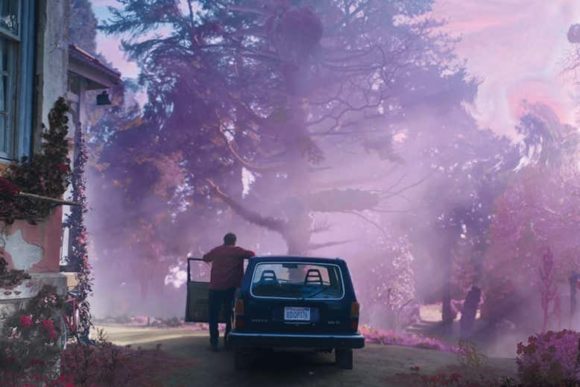Watching Color Out of Space for New Scientist, 12 February 2020
Nicholas Cage’s efforts to clear his debts after 2012’s catastrophic run-in with the IRS continue with yet another relatively low-budget movie, Color Out of Space, a film no-one expects much of. (It’s in US cinemas now; by the time it reaches UK screens, on 28 February, it will already be available on Blu-Ray.)
Have you ever watched a bad film and found yourself dreaming about it months afterwards? Color Out of Space is one of those.
To begin: in March 1927 the author H. P Lovecraft wrote what would become his personal favourite story. In “The Color Out of Space”, a meteor crashes into a farmer’s field in the Massachusetts hills. The farmer’s crops grow huge, but prove inedible. His livestock go mad. So, in the end, does the farmer, haunted by a colour given off by a visiting presence in the land: a glow that belongs on no ordinary spectrum.
This is Lovecraft’s riff on a favourite theme of fin-de-siecle science fiction: the existence of new rays, and with them, new ways of seeing. The 1890s and 1900s were, after all, radiant years. Victor Schumann discovered ultraviolet radiation in 1893. Wilhelm Röntgen discovered X-rays in 1895. Henri Becquerel discovered radioactivity in 1896. J. J. Thomson discovered that cathode rays were streams of electrons in 1897. Prosper-René Blondlot discovered N-rays in 1903 — only they turned out not to exist: an artefact of observational error and wishful thinking.
And this is pretty much what the local media assume has happened when Nathan Gardner, the not-very-effective head of a household that is downsizing after unspecified health problems and financial setbacks, describes the malevolent light he catches spilling at odd moments from his well. The man’s a drunk, is what people assume. A fantasist. An eccentric.
The film is yet another attempt to fuse American Gothic to a contemporary setting. Director Richard Stanley (who brough us 1990’s Hardware, another valuable bad movie) has written a script that, far from smoothing out the discrepancies between modern and pre-modern proprieties, manners, and ways of speaking, leaves them jangling against each other in a way that makes you wonder What On Earth Is Going On.
And what is going on, most of the time, is Nicholas Cage as Gardner. Has anyone before or since conveyed so raucously and yet so well the misery, the frustration, the rage, the self-hatred of weak men? Every time he gets into a fist-fight with a car interior I think to myself, Ah, Nicholas, c’est moi.
Even better, Cage’s on-screen wife here is Joely Richardson, an actress who packs a lifetime’s disappointments into a request to pass the sugar.
Alien life is not like earth life and to confront it is to invite madness, is the general idea. But with tremendous support from on-screen children Madeleine Arthur and Brendan Meyer, Cage and Richardson turn what might have been a series of uninteresting personal descents into a family tragedy of Jacobean proportions. If ever hell were other people, then at its deepest point you would find the Gardner family, sniping at each other across the dinner table.
Color Out of Space mashes up psychological drama, horror, and alien invasion. It’s not a film you admire. It’s a film you get into internal arguments with, as you try and sort all the bits out. In short, it does exactly what it set out to do. It sticks.

